The year started with hope. As 2022 arrived, America and most countries (China excepted) were emerging from two years of difficult lockdowns and Covid. The good news was that a flood of money from the U.S. government had buoyed the stock market and I’ve long observed that in a rising equities market, LSA and SP kit aircraft sell well.
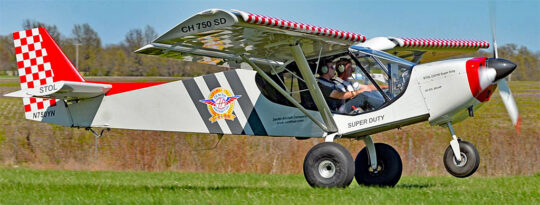
Taking off in a new year, some things remain the same. Zenith is still the clear market leader, but here’s some nuances…
No one thinks this is because anyone sells stock to buy a Light-Sport Aircraft. Rather, it’s something economists call the “wealth effect,” where rising asset values give stockholders confidence that good times are here and they can buy an airplane to have fun.
Then… Russia invaded Ukraine and global markets trembled.
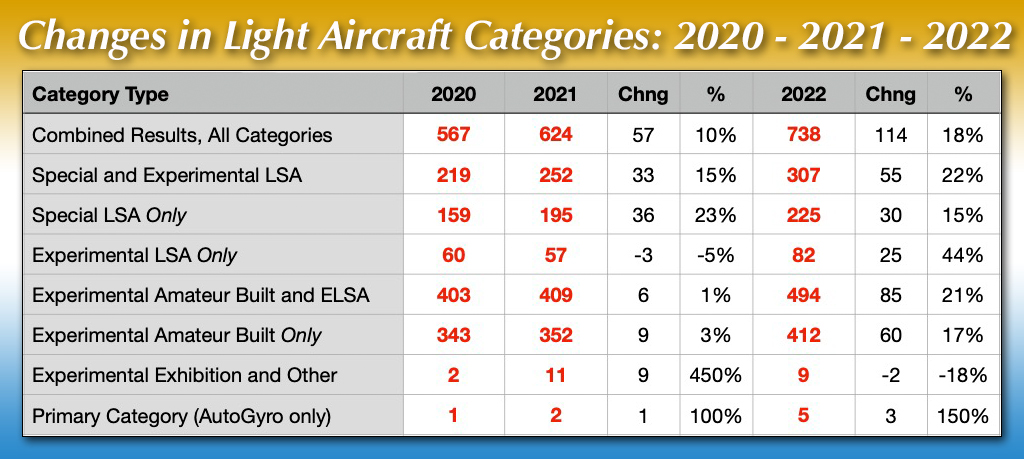
Data source: FAA registration database current through the end of 2022 — graciously and expertly provided by Steve Beste. Category explanations are provided below.
Despite a year of war, of plunging stock markets and sky-high energy prices, of protests and riots in multiple countries, plus on-going supply chain strains and lingering Covid fears, the light aircraft nonetheless grew by a very healthy 18%, after rising 10% in 2021. The industry is now performing better than in 2019, the last year of relative sanity before Covid lockdowns. (See my full 2019 report here or track all LSA market history here.)
Let’s Unpack the Numbers
I am using a different approach this year, partly to give added perspective given the challenging start to the 2020s. You can get so much detail on our Tableau Public market share data website — with an enormous THANKS! to Steve Beste for his faithful, timely, and precise work to present this info — that I felt it useful to summarize the results from my point of view.
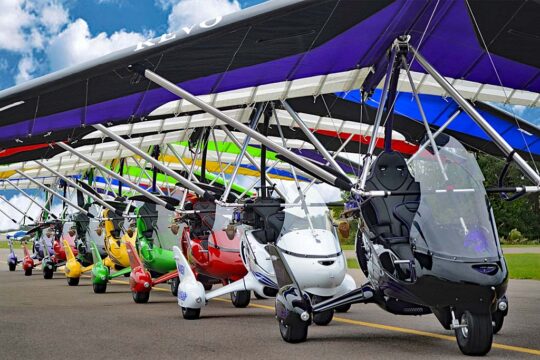
Combining bright colors with beautifully-machined hardware, this “train” of eight Revo models from Evolution Trikes is certain to turn heads.
I grouped all the light aircraft data into these categories:
- Combined Results, all categories, including fully-built, kit-built, factory-built kits (ELSA), and others, even portraying how FAA’s 1990s-era Primary Category touches this segment.
- SLSA and ELSA are presented as a group because all must start out identical to the SLSA model first accepted by FAA. After an ELSA owner takes delivery, that person can make changes without factory approval but then loses the chance to offer compensated flight instruction or rental of their aircraft.
- SLSA-only covering only ready-to-fly, separated from ELSA. SLSA can be used for compensated operations like flight instruction and rental.
- EAB and ELSA are shown as a group because in both cases the owner can alter and maintain the aircraft.
- EAB-only separates the ELSA out of the strictly homebuilt segment.
- ELSA are also shown separately as they can become quite different from the SLSA as which they began life. An owner can change avionics, interiors, add equipment, or even change the engine on an ELSA.
- Two remaining, smaller categories include Experimental Exhibition category, used mostly by Pipistrel for its motorglider models, and the Primary Category that presently counts only AutoGyro. Models that pursued Primary Category back in the 1990s (example: Quicksilver GT500) have not continued with that approach.
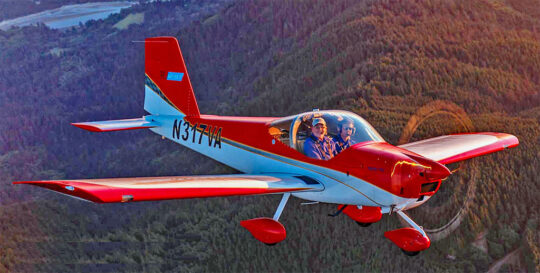
RV-12 photo from Van’s Aircraft RV-12 website. Here’s my pilot report on RV-12.
Best Selling Model — Van’s Aircraft and their RV-12 series (original 912 and newer 912iS) supplied 60 of the best-selling single model of light aircraft in the FAA registry for 2022. Of these, 13 were fully-built SLSA models; the balance of 47 RV-12s were Experimental LSA, though most left the factory essentially complete, I understand.
Going the ELSA route has attracted a certain type of buyer. RV-12 alone accounts for 43% of all such aircraft registered in 2022. Powered parachute manufacturer, Powrachute accounted for another 15 of these and Wild Sky Goat (a weight shift) registered 6 more. The remaining 18 ELSA were produced by 12 other producers. One note reveals the presence of two Bristell USA aircraft that were registered ELSA to permit IFR operations (yes, that is possible; see video here and article here).
Icon Aircraft A5; recent report.
Best-Selling Special LSA — Do you think you can guess this one? OK, I’ll skip the suspense and tell you it was Icon’s A5, which registered 33 aircraft in 2022 to lead the ready-to-fly pack. In second, fourth, fifth and sixth places were Tecnam (19 SLSA), Vashon (15), Sling (13), and Super Petrel (11)*. I left out the #3 most-registered brand in 2022 as I found it nothing short of amazing. Despite a war in its homeland and suffering direct war damage, Aeroprakt added 17 aircraft to the FAA registry in 2022. Good U.S. partners help.
One interesting factoid in the database is the 2022 registration of two Cessna Skycatchers. Since the model is long out of production — in fact, all remaining brand-new, partly-finished Skycatchers were chopped up and crushed in 2016 — one wonders how a pair of them were added to the database last year?
Check all rankings and find tons of additional insights on our Tableau Public web page. Use the lowest blue sort box on the left column. Check the relevant boxes to turn on or off any category you want to review, wait one second and the web page will assemble that request into a table. This page includes all 10,056 aircraft in the Light-Sport Aircraft and Sport Pilot kit categories. If you own one of these aircraft (registered with FAA), your aircraft is counted on this page.
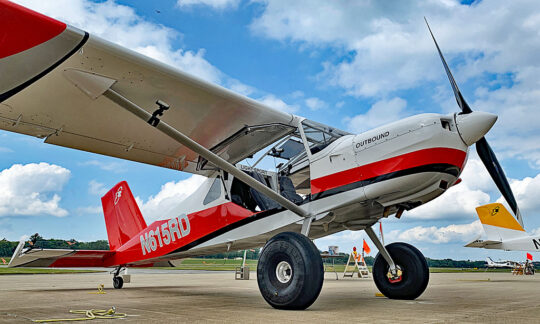
Rans’ popular S-21 Outbound sits high on big tundra tires. (Zenith’s CH-750 Super Duty is seen at the top of the page.)
Best Selling Kit Builder — Really, this should hardly be a surprise to anyone as Zenith has lead the pack almost as long as I’ve followed these statistics. Zenith has several models but their “Sky Jeep” CH-701 and -750 series contributes the bulk of their kit deliveries. Remember, kit sales don’t precisely relate to registrations as owners have to assemble them first. This can take months to years.
Trailing Zenith rather closely are the usual players: Rans (59), Sonex (45), Kitfox (38), and Just Aircraft (30). Right behind is Magni (16) because gyroplanes — other than AutoGyro’s Primary Category models (5 registered in 2022) — must be built as kits until Mosaic corrects this FAA oversight. AutoGyro also sells kit versions (15 registered). Two pleasant surprises after these leaders are Quad City Challengers (15) and Progressive Aerodyne’s Searey kits (10) though the latter company also sold 6 Special LSA models.
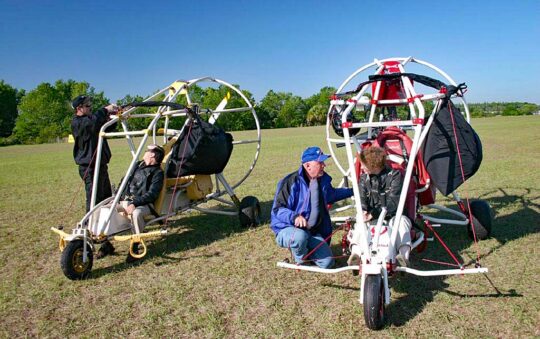
Flight school video series stars John and Martha King get their powered parachute ratings.
Among what I’ve long called “alternative aircraft” in this space, Powrachute powered parachutes registered 25 aircraft, including 16 kits and 9 SLSA models. In weight shift, Evolution Trikes was the leader with 11 registrations, of which 7 were SLSA. The company also reports good sales of its non-registered Part 103 aircraft, adding to their total.
Data hounds — you know who you are — can dive way deep into the numbers on Tableau Public. You can find all about Light-Sport Aircraft using our popular SLSA List and discover a wide range of Part 103 ultralight vehicles on our Part 103 List. (The latter are not FAA registered so do not count in this report.)
Now, go enjoy those new aircraft or a new-to-you used model you found last year!
* I used brand names and model names interchangeably in this article choosing the most common term to identify the subject. If you want more detail, type one or more words into our blue search bar at the top of the page to find any of the thousands of aircraft on this website.


Dan – I’m confused why you would state that ICON A5 was the best selling special light sport aircraft when the GAMA data clearly shows that Tecnam produced over twice a many of their LSA aircraft. Tecnam has always been a leader in this space and usually produces 2X everyone else and continues to build aircraft at a level ICON has never been able to accomplish and likely never will. Why not use the GAMA data in this analysis when it’s a more complete and factual picture? I get that not all manufactures are GAMA members but where they are they should be used. Even Cub crafters produced more than ICON. FAA reg. data is flawed in many ways as icon aircraft has ~40 aircraft registered to the company alone. They have to register new production unsold aircraft to the company first even well before they fly in order to gain a production flight certificate.
Several points…
1) GAMA data is generated by asking the companies to submit their sales reports. This will create differences from FAA registrations of that brand. This is true for virtually every company for a variety of reasons. GAMA does an excellent job but they rely on a wide variety of data submitters.
2) GAMA data represents sales to all countries. My reports focus 100% on U.S. aircraft registrations because that is the most reliable information I have available. I believe it produces the “hardest” numbers. (I have made estimates for other countries but each nation counts aircraft differently making the task daunting.) While FAA database information has errors that we have to sanitize using broad industry knowledge, the data source is as unbiased as we can get. Asking manufacturers to report their sales requires a good bit of trust or at least a long track record.
3) I am not doubting that Tecnam produces many aircraft. I know they do. However, a substantial percentage of Tecnam production does not qualify in the space I report. In addition, much of their productions goes to other countries. The same comment applies to CubCrafters that may have produced more aircraft than Icon, but not many of them will qualify as LSA. As I hope you know from my regular comments, my statistics focus entirely on Light-Sport Aircraft and Sport Pilot-eligible kit-built aircraft. In this segment, I believe our data is as good as anyone offers.
4) Finally, mixing data sources is frowned upon by any proper statistician.
Dan, thanks for all your vlogs and blogs!
Always very informative and interesting. Truely enjoy and appreciate all you do for our sport
I appreciate your kind words, Butch.
Thank you! I’ve always been curious as to how popular are various models I’ve lusted over.
Dan, this is a superb analysis. Thank you for digging in. We data hounds — and yes, we DO know who we are — appreciate it.